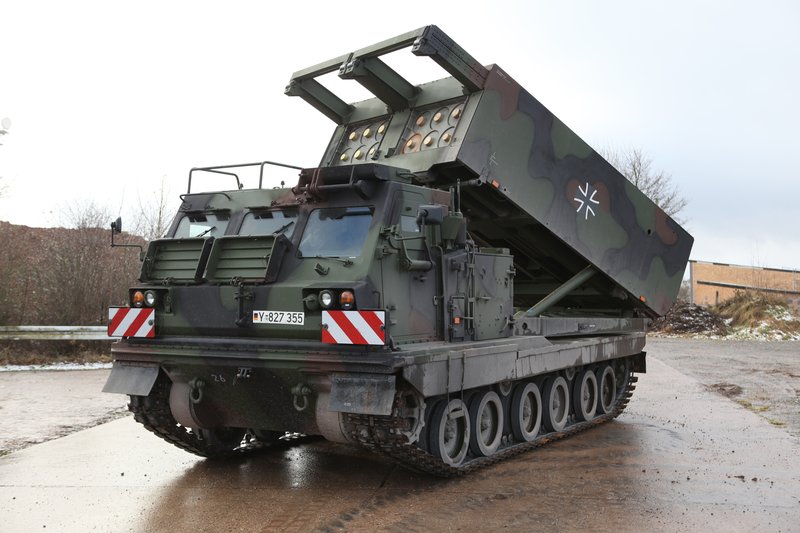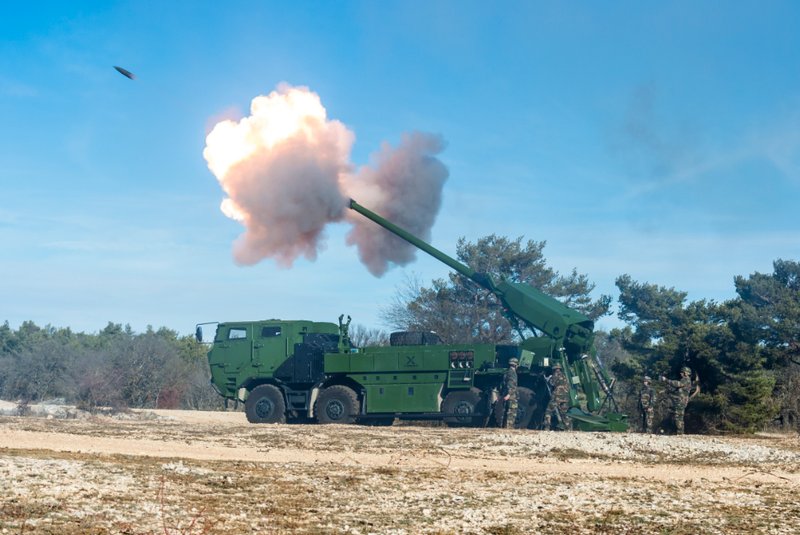News from the front – how Ukraine’s long war is changing attitudes to artillery
The Future Indirect Fires conference, held in Bristol, UK, early in March saw many key artillery users and industry speakers update a specialist audience on the latest developments in the field. Naturally, the war in Ukraine was a prominent topic.
The way artillery is used by both sides in the ongoing conflict unsurprisingly attracted a lot of attention. Here, dispersed artillery platforms are using shoot-and-scoot tactics wherever possible to avoid counter-battery fire... Continues below
Newsletter Sponsors:

Above: Countries including Germany and the UK have passed some of their tracked M270-series Multiple Launch Rocket Systems to Ukraine along with their associated rockets. (Photo: KMW)
Deploying artillery systems in well-camouflaged hides also increases survivability. When required, these guns or launchers move to the firing position, which may have some ammunition pre-positioned, carry out the mission and return to cover.
While much of the terrain in Ukraine is wooded, there are open spaces and tracks made by all types of vehicles, including artillery systems, can often easily be seen from above, especially when it has snowed. Following these tracks naturally leads to the platform.
A further aspect highlighted by the representative from Ukraine at the conference was the massive increase in the use of UAVs of all sizes on the battlefield.
These have been traditionally used for reconnaissance and post-strike damage assessment, but are now employed increasingly for offensive uses including dispensing top attack munitions to penetrate the vulnerable upper surfaces of AFVs.

Explore armored vehicles and turret systems of Otokar, the global land systems manufacturer.
Logistics vehicles are also vulnerable when they deliver ammunition, fuel and other essential supplies, without which forward units cannot sustain combat operations.
Neutralising high-value larger UAVs is a high priority for both sides, with smaller drones being very difficult to detect and counter, especially when operating in swarms.
Camouflage and deception are being used by both sides with Ukraine targeting high-value Russian artillery location radars which have an electronic signature when operating.
While Ukraine still uses a variety of Russian towed and self-propelled (SP) artillery, especially of 122mm and 152mm calibre, it is moving to NATO standards of 105mm and 155mm as the West has famously provided a large number of weapons of this type as well huge quantities of ammunition.
Russian artillery rocket systems are still used by Ukraine, but increasing numbers of six-round M142 HIMARS are now being deployed alongside a smaller number of older tracked M270 MLRS launchers.
In addition to firing older unguided 227mm M30- and M31-series rockets, MLRS have also used munitions dispensing AT-2 antitank mines and Guided MLRS rounds to engage high-value targets with precision effect at much longer ranges of over 70km.

This will be followed by the Extended Range GMLRS which is effective out to 499km thanks to more propellant.
Despite their size, both HIMARS and MLRS are mobile enough to use the shoot-and-scoot tactics described above.
The conflict also has knock-on effects for donor nations, of course. The UK Royal Artillery transferred some 30 AS90 155mm/39cal artillery systems to Ukraine and to bridge the gap until the arrival of the Mobile Fires Platform (MFP) 14 BAE Systems Bofors Archer 155mm SP artillery systems are being supplied from Swedish Army stocks and these should all be in the UK by April.
The original MFP requirement was for 116 systems, and the rumour at the conference was that the KMW Remote Controlled Howitzer 155 (RCH 155) was the preferred option.
This is based on the ARTEC Boxer 8x8, of which some 623 have been ordered for the British Army in several variants.
The RCH 155 was developed as a private venture many years ago and is now in production for Ukraine with 18 systems to be supplied from KMW’s Kassel production line.

The German Army also has a likely requirement for up to 200 RCH 155s and potential export customers include Switzerland where it is in competition with the Archer. Italy represents another opportunity as it still deploys the towed 155mm/39cal FH-70 which was developed over 50 years ago.
This all reflects the increasing trend towards wheeled SP artillery systems, which have greater strategic mobility and can be deployed over long distances under their own power.
The French Army will soon have a fleet of 109 of the latest CAESAR Mk II 6x6 SP howitzers and export sales have been made to many countries.
The baseline CAESAR carries 18x155mm projectiles and associated charges. An 8x8 version based on a Tatra chassis has higher levels of mobility and can carry over 30 rounds with the option of semi-automatic loading.

Above: The first customer for the Nexter CAESAR 155 mm/52cal 8x8 SP artillery system based on a Tatra chassis was Denmark, which has now passed its complete fleet to Ukraine. (Photo: Nexter)
Elsewhere, Rheinmetall and Elbit Systems are cooperating on a 10x10 SP artillery system which will be known as Sigma in Israel Defence Forces service.
The German version is based on the latest Rheinmetall MAN Military Vehicles HX truck fitted with a 155mm/52cal ordnance. There is growth potential to 60cal to enable ranges of 70km to be achieved.
Nonetheless, tracked SP artillery systems are still deployed by many countries and the KMW PzH 2000 is now back in production for the German Army which in 2023 placed a contract for ten new systems to replace examples passed to Ukraine. There is also an option on another 18 in three batches of six.
In the US, the BAE Systems 155mm M109 series has been built in huge numbers for home and export markets but is still fitted with a 39cal ordnance which limits its effective range.
The XM1299 58cal Extended Range Cannon Artillery has just been cancelled and would have provided a step-change in range for the US Army if it had been fielded. An alternative solution must now be found.
The best-selling tracked SP artillery system in recent years has been the Hanwha K9 Thunder which is fitted with a 155mm/52cal ordnance and was developed to meet the requirements of the Republic of Korea Army alongside the K10 ammunition resupply vehicle.
The K9 has now been ordered or deployed by an increasing number of users including Australia, Egypt, Estonia, Finland, India, Norway, Poland (Krab), South Korea, Turkey (Firtina) and Ukraine.
The original K9 was followed by the K9A1 and K9A2, mapping a clear growth path with a longer 58cal ordnance and greater automation to reduce the crew complement.
Other articles in this newsletter:
Supporting roles – why forward repair systems are an in-demand capability
Howitzers, whether tracked or wheeled are no use without ammunition, something Ukraine is notably short of. Despite looming political question marks over future aid, many contractors in the US, Europe and elsewhere have stepped up production of artillery rounds, mainly 155mm, but some countries in the West are also supplying 122mm and 152mm ammunition.
For example, the US was producing only 14,000 155mm projectiles a month pre-war, but this has already increased to a rate of 40,000 with further expansion planned.
In addition to high-explosive, smoke and illuminating natures of 155mm ammunition, the US has also supplied Ukraine with M483 projectiles which carry 64 M42 and 24 M46 dual-purpose sub-munitions.
Ukraine has also confirmed that it has been successfully using Raytheon 155mm M982 Excalibur and Diehl/Leonardo Vulcano precision-guided munitions to engage high-priority Russian targets.

Above: Many contractors in Europe are now stepping up ammunition production for Ukraine. This is a BAE Systems facility manufacturing 155mm artillery projectiles. (Photo: BAE Systems)
Providing more ammunition to Ukraine is just one part of the problem as there are other consumables such as artillery and tank gun barrels.
On a 155mm artillery system firing at top charge, the actual barrel could well last for only 1,000 rounds and if used beyond this point shells start to fall short.
According to the conference speaker from Ukraine, Russia was firing anything up to 30,000 rounds of artillery ammunition a day, although this has now been reduced.
For its part, Ukraine deploys its artillery and mortars as far forward as possible to give maximum range into enemy territory, but moves its weapons around as often as possible.
In certain cases, with towed artillery such as the 122mm D-30 gun and some mortars, once a fire mission is carried out the crew move to a safe distance clear of counter-battery fire, leaving the weapon itself behind.
Artillery and mortar fire has caused 80% of casualties in the war, although this should not have come as a surprise as similar figures have been seen in previous conflicts.
Before the outbreak of these particular hostilities, many believed that future conventional conflicts would be short and sharp, such as the Six-Day War and Operation Desert Storm.
In the early days of fighting there was some scope for manoeuvre warfare, but today it is almost a static conflict with, on the Russian side, at least three lines of defences with anti-tank and anti-personnel minefields that have proved very difficult to breach, even with Western supplied combat engineer vehicles fitted with mine clearing equipment.
This has led to heavy losses of material and people, and the consumption of huge quantities of ammunition on both sides which have been difficult to replace.
Where does this leave the artillery? While air power, be it fixed-wing or rotary, is valuable, only field artillery can rapidly provide fire support on a 24/7 basis.
Indeed as one speaker said, ‘air power cannot replace organic firepower’ while another added that ‘field artillery can today provide suppressive firepower as well as precision attack’.
As long as the war lasts, artillery systems and their vital ammunition supplies will of necessity feature heavily.
Don't want to miss out on future Decisive Edge content? Make sure you are signed up to our email newsletters.













